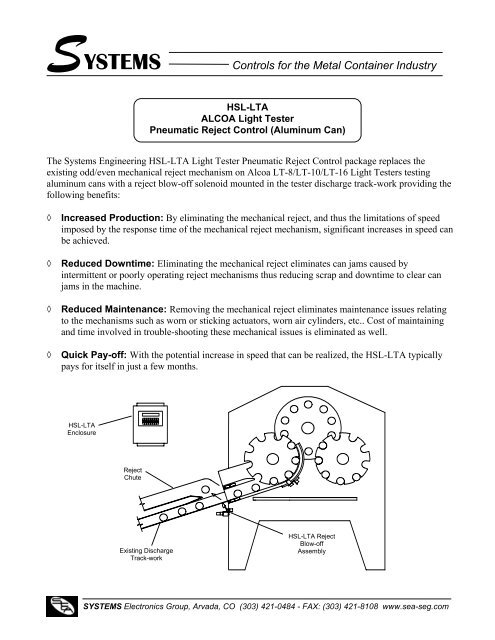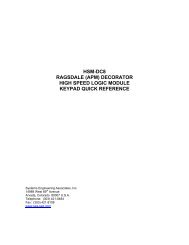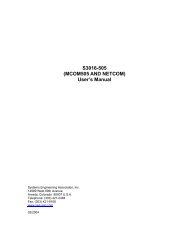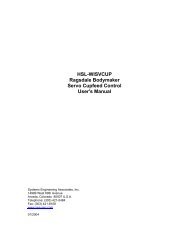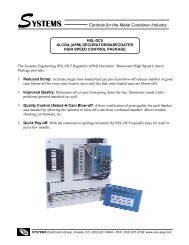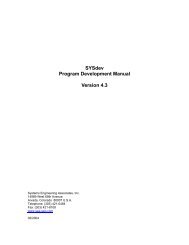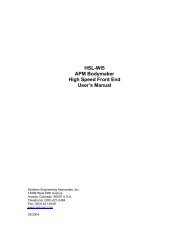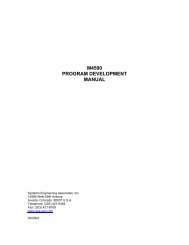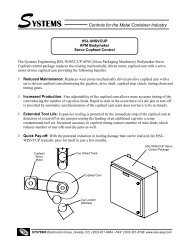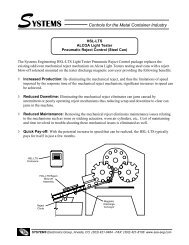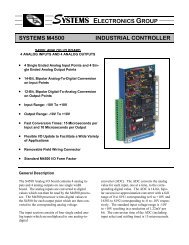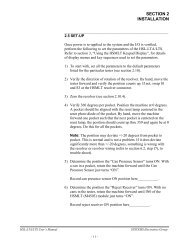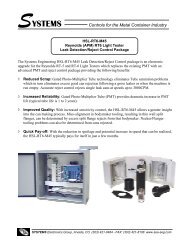HSL-LTA: Alcoa Light Tester Pneumatic Reject Control - Sea-Seg.com
HSL-LTA: Alcoa Light Tester Pneumatic Reject Control - Sea-Seg.com
HSL-LTA: Alcoa Light Tester Pneumatic Reject Control - Sea-Seg.com
- No tags were found...
Create successful ePaper yourself
Turn your PDF publications into a flip-book with our unique Google optimized e-Paper software.
Vision Inspection System <strong>Reject</strong>The package can optionally except a reject signal from avision inspection system and reject these cans at the samedischarge mounted reject blow-off solenoid. The visionsystem reject signal must occur between the infeed loadlocation on the tester and the discharge of the tester. Thevision reject signal must also be synchronized with themachine. The optional <strong>HSL</strong>-LTDVR Leaker/Visiondiverter solenoid allows leaker rejects to be separatedfrom vision rejects in separate bins for inspection.Alarm DetectionThe package detects the following alarms: Leak DetectionArray Fault, <strong>Tester</strong> Discharge Can Jam/Back-up, TimingSignal Fail, Can Presence Sensor Fail, Photo Eye LensesDirty Fault and Missed <strong>Reject</strong> Detection (option). TheLeak Detection Array Fault occurs when a fault in a leakdetector array head occurs. The <strong>Tester</strong> DischargeJam/Back-up is generated if either a jam or back-upoccurs at the discharge of the tester or if the <strong>Reject</strong> PhotoEye fails.The Timing Signal Fail occurs when any of the timingsignals generated in the PLS section fails to change stateperiodically while the machine is running. Can PresenceSensor Fail occurs when the sensor fails to detect canswhile cans are flowing through the machine. The PhotoEye Lenses Dirty Fault indicates that the lenses of thephoto eye mounted on the <strong>Reject</strong> Blow-off assembly arecontaminated and need to be cleaned or are damaged andneed to be repaired. The Missed <strong>Reject</strong> Detection occurswhen a can is not detected as being rejected when thereject blow-off is activated. This alarm is implementedusing the optional <strong>HSL</strong>-LTRV reject verification sensorswhich are mounted in the reject chute.“HSMLT” Setup ProgramThe “HSMLT” setup program allows the user to easilyview the <strong>HSL</strong>-<strong>LTA</strong> data or alter the <strong>HSL</strong>-<strong>LTA</strong> setupvariables using an IBM PC or <strong>com</strong>patible. Thesevariables include: Can Presence to discharge number ofshifts, leak detector to discharge number of shifts, visionreject to discharge number of shifts, Can neck size, <strong>Reject</strong>pulse time, Diverter Solenoid pulse time, and the machinetiming set-points. In addition to setting the variables,“HSMLT” can be used to view the current and last shiftdata, view the rejects per pocket, download the <strong>HSL</strong>-<strong>LTA</strong>application program to the M4503 as well as downloadand upload the setup data to the M4503.Data CollectionThe following data is collected for both the current shiftand the previous (last) shift: Total number of good canstested, total number of leak cans rejected, total number ofvision rejects, and the total rejects per pocket. This data isviewed on the display of the <strong>HSL</strong>-<strong>LTA</strong>. The informationis updated (“current” shift transferred to “last” shift)based on the change of state of a discrete input.In addition to the shift data collection, a separate buffer isavailable to collect rejects per pocket counts as adiagnostics aid to the operator for trouble-shooting a lightseal problem on a specific pocket. Unlike the shift data,these counts can be reset manually by the operator at will.This allows the operator to note an abnormally high counton a specific pocket, attempt to correct the problem, resetthe counts and then check the counts at a later time todetermine if the problem is corrected.<strong>HSL</strong>-<strong>LTA</strong> Keypad / DisplayThe <strong>HSL</strong>-<strong>LTA</strong> package is based on the M4503PLC/PLS/Display module. The keypad of the M4503contains 24 keys consisting of data display <strong>com</strong>mands,setup <strong>com</strong>mands, and a numeric keypad. The display ofthe M4503 is a 2 line by 40 character back-lit LCDdisplay which displays the selected data and setup menus.The keypad/display can be used by the operator to viewthe current and last shift data as well as the rejects perpocket diagnostic data. In addition, the keypad/display isused to activate the <strong>Reject</strong> Blow-off Solenoid test featureand can be used by authorized personnel (passcode or keyswitch protected) to adjust the timing and all setupparameters.<strong>Tester</strong> RequirementsThe reject blow-off assembly is mounted in the dischargetrack-work at the immediate exit of the tester. The can isrejected up out of the discharge track-work into a rejectchute, both customer provided. This requires a straightsection of track-work 18” long from where the track-workmates to the tester discharge. An opening in the top ofthis 18” is made for a reject clearance and to mount adischarge funnel plate.For air tunnels, the upper lips of the air tunnel must becut-off, welded to the plenum, and ground flush. Forgravity track-work, the upper half-round rails are cut-off.In either case a new reject chute must be manufactured orthe existing reject chute is modified to interface with thenew reject blow-off system.SYSTEMS Electronics Group, Arvada, CO (303) 421-0484 - FAX: (303) 421-8108 www.sea-seg.<strong>com</strong>
SpecificationsPower Requirements:Voltage: 100-240VAC, 50/60HZCurrent: 0.5 Amps @ 115VAC0.25 Amps @ 230VACVoltage: +24VDCCurrent: 2.0 AmpsCompressed Air: 90-110psi @ 0.25 SCFMTemperature Ranges:Operating: 0 to 55°CStorage: 0 to 70°CResolver Interface:Resolver Type: Systems Electronics GroupRSV34-MS1Resolver Cable: Systems Electronics GroupRSV-RSCBLE-XX<strong>Control</strong> Inputs:Voltage Range: 10-30VDCInput “On” Voltage (min): 10.0 voltsInput “On” Voltage (max): 30.0 voltsInput “Off” Voltage (max): 5.0 voltsInput Current (max): 15 milliamps @ Vin=30VOptical Isolation: 1500 VrmsOutputs:Voltage Range: 10-30VDCOutput “On” Voltage (min): VCC-2.00 voltsOutput “On” Voltage (max): VCC-0.25 voltsOutput “Off” Voltage (max): 1.5 voltsOutput “On” Current (max-cont): 0.5 Amps DCOutput “On” Current (100msec): 3.0 Amps DCOptical Isolation: 1500 VrmsOrdering InformationThe <strong>HSL</strong>-<strong>LTA</strong> package includes a 14” X 12” X 8” NEMA 12 enclosure which should be mounted in close proximity tothe tester. An addition, a reject blow-off assembly is provided which is mounted in the discharge of the tester. The ordernumber for the <strong>HSL</strong>-<strong>LTA</strong> is as follows:Part Number<strong>HSL</strong>-<strong>LTA</strong>Description<strong>Alcoa</strong> <strong>Light</strong> <strong>Tester</strong> <strong>Pneumatic</strong> <strong>Reject</strong> <strong>Control</strong> package (for aluminumcan) including the following:1ea.1ea.1ea.1ea.1ea.1ea.1ea.1ea.1ea.<strong>HSL</strong>-<strong>LTA</strong>/LTS Enclosure (14” X 12” X 8”) with M4503 <strong>Reject</strong><strong>Control</strong> Module.BRK-LTB-SOL <strong>Reject</strong> Blow-off Assembly with blow-offsolenoid and Fiber Optic Photo Eye.BRK-LTB-HD Hardware Kit including funnel plate andmounting brackets.BRK-LTB-PRX Can Presence SensorRSV34-MS1 ResolverRSV-RSCBLE-100 Resolver Cable<strong>HSL</strong>-<strong>LTA</strong>/LTS User’s Manual<strong>HSL</strong>-<strong>LTA</strong>/LTS Program DiskM4500 User’s Manual<strong>HSL</strong>-<strong>LTA</strong> Options (purchased separately)Part Number<strong>HSL</strong>-LTRV<strong>HSL</strong>-LTDVRDescription<strong>Reject</strong> Verification Sensors (to be mounted in reject chute)Leaker/Vision Diverter Solenoid Assembly (to be mounted inreject chute)SYSTEMS Electronics Group, Inc.Division of SYSTEMS Engineering Associates, Inc.14989 W. 69 th Ave., Arvada, CO 80007Telephone: (303) 421-0484 FAX: (303) 421-8108 www.sea-seg.<strong>com</strong>


